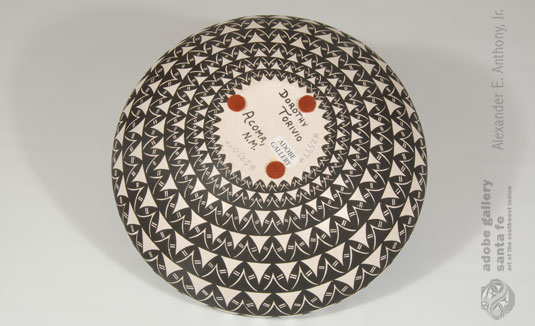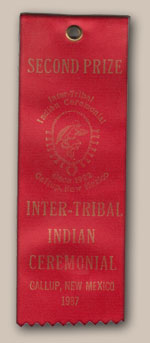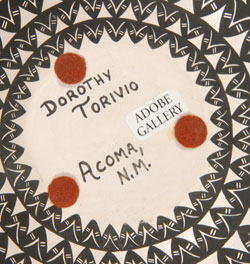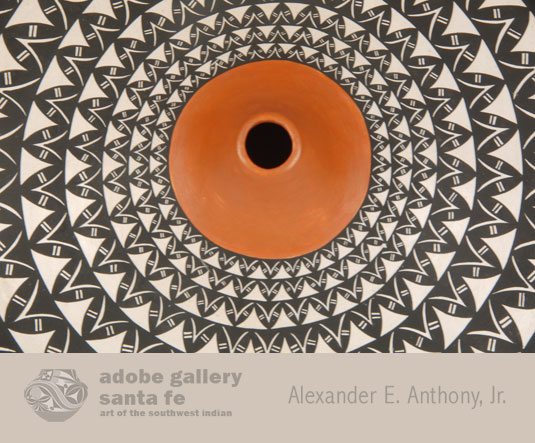Gallup Ceremonial Award Winning Acoma Seed Jar [SOLD]
+ Add to my watchlist Forward to Friend
- Category: Modern
- Origin: Acoma Pueblo, Haak’u
- Medium: clay, pigment
- Size: 4” height x 7-1/4” diameter
- Item # 25974 SOLD

 Thirteen concentric circles expanding from a width of ¼ inch at the neck of the jar to a width of ¾ inch at the shoulder, then reversing on the underside, decreasing to a width of ¼ inch again, is a feat that appears to be as difficult a design concept as a potter could conceive. Within each circle are black and white V-shape designs that expand and contract within the rows of circles. It is no wonder that this was an award winner at the 1987 Gallup Inter-tribal Indian Ceremonial.
Thirteen concentric circles expanding from a width of ¼ inch at the neck of the jar to a width of ¾ inch at the shoulder, then reversing on the underside, decreasing to a width of ¼ inch again, is a feat that appears to be as difficult a design concept as a potter could conceive. Within each circle are black and white V-shape designs that expand and contract within the rows of circles. It is no wonder that this was an award winner at the 1987 Gallup Inter-tribal Indian Ceremonial.
Dorothy Torivio was the most progressive artisan at Acoma Pueblo as early as the 1980s. She was born at Acoma Pueblo and is renowned for her innovative work in exaggerated seed-pot forms in large and miniature sizes. She painted her hand-coiled and outdoor-fired pots with black and white or polychrome patterns of staggering intricacy, painted fresh, and with beautiful precision.
 Torivio extrapolated the innovative forms and decorations that were initiated by the famous Acoma potters of previous generations—Lucy Lewis and Marie Z. Chino. She learned to make pottery from her mother-in-law, Lolita Concho, who taught her how to paint fine lines. She, herself, devised the method of choosing a design and repeating it over and over in a geometric pattern. Each design element in her repertoire has its root in prehistoric Mimbres symbols.
Torivio extrapolated the innovative forms and decorations that were initiated by the famous Acoma potters of previous generations—Lucy Lewis and Marie Z. Chino. She learned to make pottery from her mother-in-law, Lolita Concho, who taught her how to paint fine lines. She, herself, devised the method of choosing a design and repeating it over and over in a geometric pattern. Each design element in her repertoire has its root in prehistoric Mimbres symbols.
This jar would have been made in 1987. Gallup Ceremonial rules state that items may be entered only in the year they were made.
Condition: original condition
Provenance: from a gentleman in Santa Fe
Recommended Reading: Art of Clay - Timeless Pottery of the Southwest by Lee M. Cohen

- Category: Modern
- Origin: Acoma Pueblo, Haak’u
- Medium: clay, pigment
- Size: 4” height x 7-1/4” diameter
- Item # 25974 SOLD



